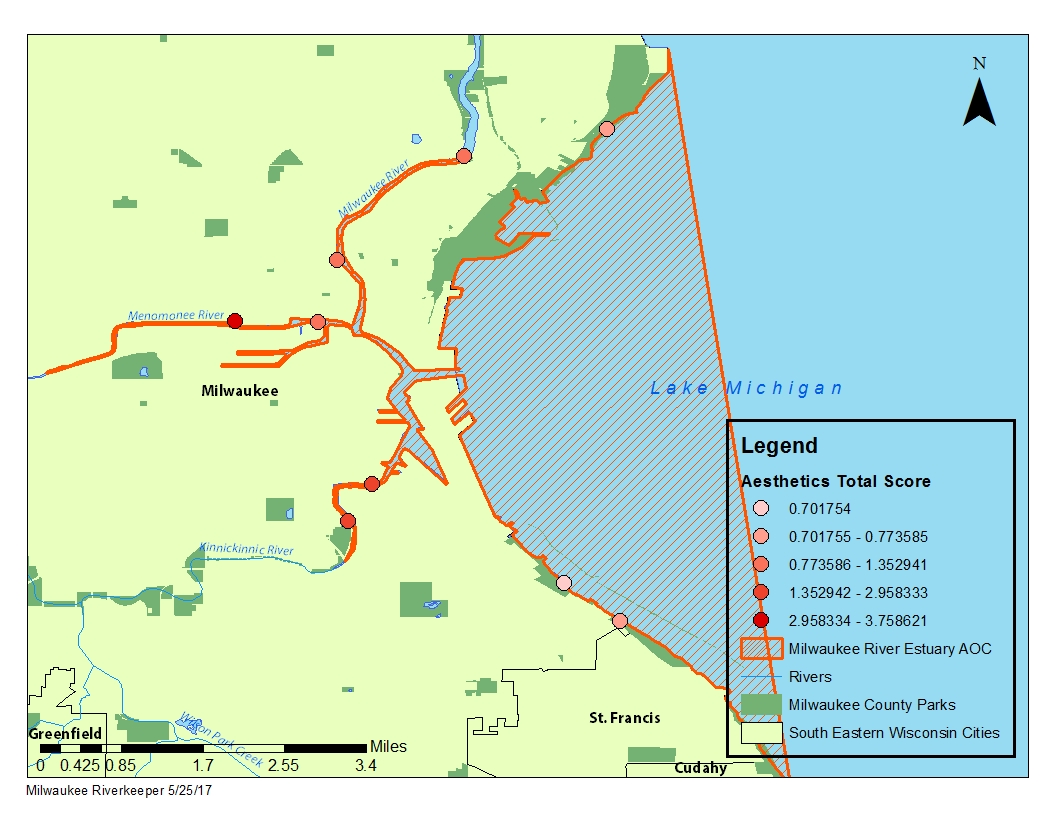Aesthetics Monitoring
Milwaukee River Estuary Area of Concern
In the early 1970’s, following massive algae blooms and fish kills, newspaper headlines declared that Lake Erie was “dead”. Articles about extreme pollution in the Cuyahoga River in Northeastern Ohio were often accompanied by photos of the famous Cuyahoga River fire, a three day period where the river itself caught fire due to high levels of contamination. By the late 1960’s and early 1970’s, the Great Lakes and their surrounding watersheds had been subject to such extensive environmental degradation that it became apparent a binational and multi-state solution would be necessary.
In 1978, government officials from the United States and Canada drafted the Great Lakes Water Quality Agreement. The agreement emphasized the need for collaborative efforts to restore the ecological health of the Great Lakes by focusing on key pollutants of concern. A major component of the Agreement was also the designation of 43 Areas of Concern (AOC’s) throughout the Great Lakes Region. Areas of Concern, such as the Milwaukee River Estuary (Figure 16), were designated based on the observed and anticipated ecological impacts associated with historic industrial activity and legacy pollution in each of the 43 locations. In other words, sites listed as AOC’s were considered to be critically degraded as compared to other similar, often urban, areas of the Great Lakes, and were determined to be in dire need of restoration to overcome existing legacy contamination.
To track those ecological impacts, and the progress of restoration and cleanup efforts in each AOC, the Agreement included a list of Beneficial Use Impairments (BUI’s) associated with each AOC. A BUI can be thought of as “symptom of pollution” that can be monitored and assessed to help gauge the health of an AOC over time. Of the 14 potential BUI’s, the Milwaukee River Estuary AOC has 11, ranging from contaminated sediments and fish health issues to degradation of aesthetic value.
Aesthetics Monitoring
In partnership with the WDNR and the US EPA, during 2015 and 2016, Milwaukee Riverkeeper organized a team of volunteers to rate the aesthetic value of various sites throughout the Milwaukee River Estuary. For this project, participants traveled to 9 sites total: two each on the Milwaukee, Menomonee, and Kinnickinnic Rivers; and three Lake Michigan beach sites – Bayview Beach, Bradford Beach, and South Shore Park Beach (Figure 16). The results of these assessments will be used to determine what progress has been made in the AOC to address the degradation of aesthetics BUI, and to evaluate whether a BUI can be removed. Unlike other monitoring programs organized by Milwaukee Riverkeeper, aesthetics monitoring involves little training and is left almost entirely in the hands of community volunteers.
- Aesthetics monitors visit a specific site and answer a WDNR prepared survey that contains a series of questions evaluating the aesthetics of each site.
- Volunteers answer questions like: “Are deposits of trash along the shoreline impacting your appreciation of this site?”, or “Does nuisance vegetation prevent you from accessing, enjoying or using the water?”
- Survey results are compiled and analyzed to assess the “aesthetic impression score” of each site. To make sure that these scores represent a variety of perspectives of people living in or near the Milwaukee AOC, a minimum of 35 different people fill out a survey for each site during three seasons each year. Between 2015 and 2016, 143 total volunteers completed 962 surveys.
Survey Says
Since each survey asks for answers to specific questions about each volunteer’s experience at different sites, as well as for qualitative explanations of those answers, our results identify specific trends regarding perspectives of the aesthetics at each site, as well as common diction used to describe those perspectives. Sticking with the previous comparison, Emmber Lane, a site rated with significant nuisance gulls, associates strongly with words like feces and bird, while monitors at Bayview Beach mentioned debris and litter along the shoreline of that site more often. Additionally, since Bayview Beach received a higher aesthetic score, words that appear more consistently, like clean and quiet, demonstrate positive public perceptions of aesthetics.
The map below shows the extent of the Milwaukee River Estuary Area of Concern, and the total aesthetics score associated with each site monitored by Milwaukee Riverkeeper volunteers in 2016.
BUIs and the AOC
To remove a BUI from an AOC, local agencies such as WDNR must make a case to the US EPA that significant progress has been made to alleviate a specific impairment, and that as a result, the AOC is currently meeting the publically approved goals for that impairment (as set out in a Remedial Action Plan for each AOC). Trends recorded during the 2015-2016 Milwaukee Riverkeeper Aesthetics Monitoring Program, looking at total aesthetics impression scores each year throughout the Milwaukee River Estuary, highlight public perspectives on the progress of restoration efforts over time and help identify specific restoration needs in the Milwaukee River Estuary. Thanks to the involvement of volunteers, we can begin to understand if we are closer to meeting our goals to remove this BUI, and/or to better understand what it will take to improve the aesthetic perception of sites around our AOC.
Our aesthetics project is complete!
Our aesthetics monitoring project was completed in 2017. For other opportunities to get involved with water quality monitoring please contact our Water Quality Volunteer Coordinator Katie Rademacher or call (414) 287-0207 x4.

Thanks to our funders for their generous support of this program!

